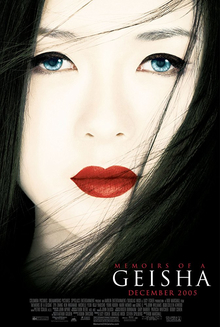Monday, February 27, 2006
Geisha

Last Sunday evening I was at the cinema to see the adaptation of the Arthur Goldens bestseller 1997 novel "Memoirs of a Geisha". I was seduced both by the promissing trailer and by the book, which I read four years ago. The book left a strong impression on me because it gave me a glimpse into a secret world in the japanese society, culture which I am particularly fond. The book tells a story about the life as a Geisha in Gion, one of the suburbs of Kyoto. The book has been focus of some controversy, since the author based most of the novel on interviews he had with a real former Geisha - Mineko Iwasaki - who later wrote "Geisha of Gion" in order to give her own corrected version of her life. The main fuss was dued to the fact that the interviews were supposed to be anonimous, but the author thanked Mineko Iwasaki in the acknowledgments of the novel, exposing her identity. Another point of conflict was the way he portrayed her life and the relationship she had with her rivals in the book. The mizuage ceremony (old tradition that has disappeared in the turn of the 20th century - the geishas were initiated by loosing their virginity to the highest bidder, passing from maiko to geisha, or geiko) was, according to Iwasaki, uncorrect and not based in any actual event of her life.
In Asia, much ado was motivated by the fact that the three leading characters in this movie are played by chinese actresses - Zhang Ziyi, Gong Li and Michelle Yeoh (malaysian of chinese descent). Some people saw it as an error of casting, by ignoring the cultural diversity in Asia. Its premier was cancelled in China because the use of chinese actresses performing as geishas could rise anti-japan sentiment. The spelling of the word geisha in cantonese can be misread as prostitute. Censurers claimed that the movie had potential to stir up the feelings of many chinese when one thinks of the sexual slavery perpetuated by the japanese soldiers towards chinese women during World War II. But this is a political issue. From a pure artistic point of view, I think that the choice of the cast was superb because it uses some of the most known asian faces (and the most atractive ones, I dare add!) doing parts that fit them best - who can match the serenity of Michelle Yeoh as Mameha, for example? Nevertheless, as I read in a comment from another viewer, the mingling of so many different accents and the allegoric nature of the oriental quotes and remarks makes the dialogues of this movie seem slightly patched and foreign. But maybe that is a plus for many.
The movie primes by its esthetics. The concern for the visual aspect is patent along the entire movie and image and music intertwine perfectly in an exquisite and remarkable piece for the seer. It is a delight to the senses. The story is light and easy to follow, although it is a pity how much was lost in the adaptation, in terms of psychological depth. The style of the movie is biographical and the atmosphere and the scenery almost makes us want to order a ticket in the next plain to Japan. It certainly deserves its nomination by the Academy Awards on categories like 'Best Costum Design', 'Cinematography' or 'Original Score'.
The movie also makes me think about the dangers of cultural globalization (or should I rather call it homogenization instead?). There was a time when there were more than 80 thousand geishas in Japan. Today they are not much more than one thousand, most of them concentrated in the old geisha quarters of Kyoto. The demands of modern life and the dedication required to endure a life as a geisha have eroded the will of japanese women to join the profession. Such lifestyle stopped making sense in a westernalized Japan. It may seem outrageous to a westerner the idea of paying up to 10000 dollars for an evening where the appointed entertainers "just" dance, sing and talk with their guests. But in some far away culture, such exorbitance was once seen as natural. I hope it will continue being so. For diversitys sake.
;-)
Wednesday, February 22, 2006
Intro
Hi everybody!
My name is Paulo and I live presently in Trondheim, Norway. I was born in 1978 and I work now as a researcher in the Centre for the Biology of Memory in the Norwegian University of Science and Technology.
I am fond of writing, so I decided to start a blog. I also have another personal blog in norwegian (bokmål and some occasional entries in swedish) and I contribute regularly to a portuguese blog . I post every wednesday on that blog.
I am interested in history, science, philosophy, geography, literature, cinema, politics, sports and travelling, so those are the main themes I am going to write about here in my blog.
Hope to read some nice comments from you readers and carpe diem!
;-)
Paulo.
My name is Paulo and I live presently in Trondheim, Norway. I was born in 1978 and I work now as a researcher in the Centre for the Biology of Memory in the Norwegian University of Science and Technology.
I am fond of writing, so I decided to start a blog. I also have another personal blog in norwegian (bokmål and some occasional entries in swedish) and I contribute regularly to a portuguese blog . I post every wednesday on that blog.
I am interested in history, science, philosophy, geography, literature, cinema, politics, sports and travelling, so those are the main themes I am going to write about here in my blog.
Hope to read some nice comments from you readers and carpe diem!
;-)
Paulo.